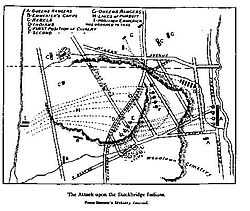Stockbridge Militia

The Stockbridge Militia was a military unit from Stockbridge, Massachusetts which served in the American Revolutionary War. The militia was composed of American Indians, mostly Mahican, Wappinger, and Munsee from the Stockbridge area. While most northeastern tribes, such as Joseph Brant's Mohawks, aligned themselves with the British, the Stockbridge tribes cast their lot with the colonies. Led by Jehoiaikim Mtohksin and Abraham Nimham, it was the first native unit to fight against the British during the revolution.[1]
Early history
In 1774, as the revolution began to get under way in Massachusetts, members of the Stockbridge tribes met at the Red Lion Inn to pledge their loyalty to the American cause:Wherever your armies go, there we will go; you shall always find us by your side; and if providence calls us to sacrifice our Lives in the field of battle, we will fall where you fall, and lay our bones by yours. Nor shall peace ever be made between our nation and the Red-Coats until our brothers -the white people- lead the way.[2]
This first incarnation of the militia served at the Siege of Boston and the Capture of Fort Ticonderoga in 1775. This militia disbanded soon thereafter, with some Indians returning to their homes and others continuing to serve as scouts for various units.
In 1777, a new militia was gradually formed as Stockbridge men from the 8th Massachusetts Regiment, Nixon's Brigade, and other units gathered under the command of Major General Horatio Gates. This new, loosely-organized Stockbridge Militia, now part of the Continental Army, was led by Jehoiaikim Mtohksin. Abraham Nimham, son of famed sachem Daniel Nimham, joined the unit as Mtohksin's second-in-command. From 1777 to 1778 they participated in the Siege of Ticonderoga, the Battle of Saratoga, and the Battle of Monmouth.
The Stockbridge Massacre

In August 1778, the Stockbridge Militia was stationed at an outpost in what is now Yonkers, New York. Their opposition came mainly from the Queen's Rangers, a unit descended from Rogers' Rangers, in which many Stockbridge had served during the French and Indian War.
On August 31, nearly forty Indians—including Abraham Nimham, his father Daniel, and twelve other Stockbridge natives—were killed in an ambush by the Rangers in the area of The Bronx that is now Van Cortlandt Park. Lieutenant colonel John Graves Simcoe led the British attack; although he was wounded along with several others,[3] the skirmish was a decisive British victory. After the fighting, Hessian captain Johann Von Ewald sketched a Stockbridge warrior based on one of the dead who had been left behind. The picture is the only known contemporary depiction of a Revolutionary-era Stockbridge militiaman. Von Ewald described the Indian casualties after his examination:
Their costume was a shirt of coarse linen down to the knees, long trousers also of linen down to the feet, on which they wore shoes of deerskin, and the head was covered with a hat made of bast. Their weapons were a rifle or musket, a quiver with some twenty arrows, and a short battle-axe, which they know how to throw very skillfully. Through the nose and in the ears they wore rings, and on their heads only the hair of the crown remained standing in a circle the size of a dollar-piece, the remainder being shaved off bare. They pull out with pincers all the hairs of the beard, as well as those on all other parts of the body.[4]
The bodies of the Indians were left on the battlefield. Soon after, local residents discovered the corpses being scavenged by dogs, and they buried them in a mass grave.[5] By the 19th century the spirit of their sachem was said to haunt the land of "Indian Field".[6]
End of service
That engagement was the last of the war for the militia; Abraham's father, Daniel Nimham, was a man of great standing among the Wappinger, and the other casualties represented a significant loss to the total population of the tribe back in Massachusetts. Requesting leave to return home to help the families of the dead, the company was paid $1,000.00 for their service and discharged by order of George Washington in September 1778.[1]
After the war, the militia saw brief action once more as they defended Stockbridge from insurgents during Shays' Rebellion.[7] It has been suggested that their service created strong support for Indian suffrage in the new Commonwealth of Massachusetts; although article five of the first draft of the state's new constitution excluded Indians as eligible voters, it was soundly defeated and the second draft gave all men the right to vote.[1]
Most of the Indian survivors eventually settled in Oneida County, New York and were later moved to Wisconsin, forming the Stockbridge-Munsee tribe.
References
- ↑ 1.0 1.1 1.2 Frazier, Patrick. The Mohicans of Stockbridge. p. 225.
- ↑ Abbott, Katharine Mixer (1907). Old Paths and Legends of the New England Border: Connecticut, Deerfield, Berkshire. pp. 228–230.
- ↑ British Losses were 4 Grenadiers and Simcoe Wounded; of the British Cavalry/Hussars 1 killed and 3 wounded. Simcoe Journal .pp.85-86
- ↑ Johann Von Ewald (1778). Diary.
- ↑ Jenkins, Stephen (1912). The Story of the Bronx. p. 303.
- ↑ Appleton's Journal of Literature, Science and Art. Appleton & Co. 1872.
- ↑ Green, Mason Arnold (1888). Springfield, 1636–1886. C.A. Nichols & Co. p. 327.
External links
- Death in the Bronx: The Stockbridge Indian Massacre
- City of New York Parks and Recreation — Indian Field
- Stockbridges - Patriot Mahican Continental Army Troops in the American Revolution (video)